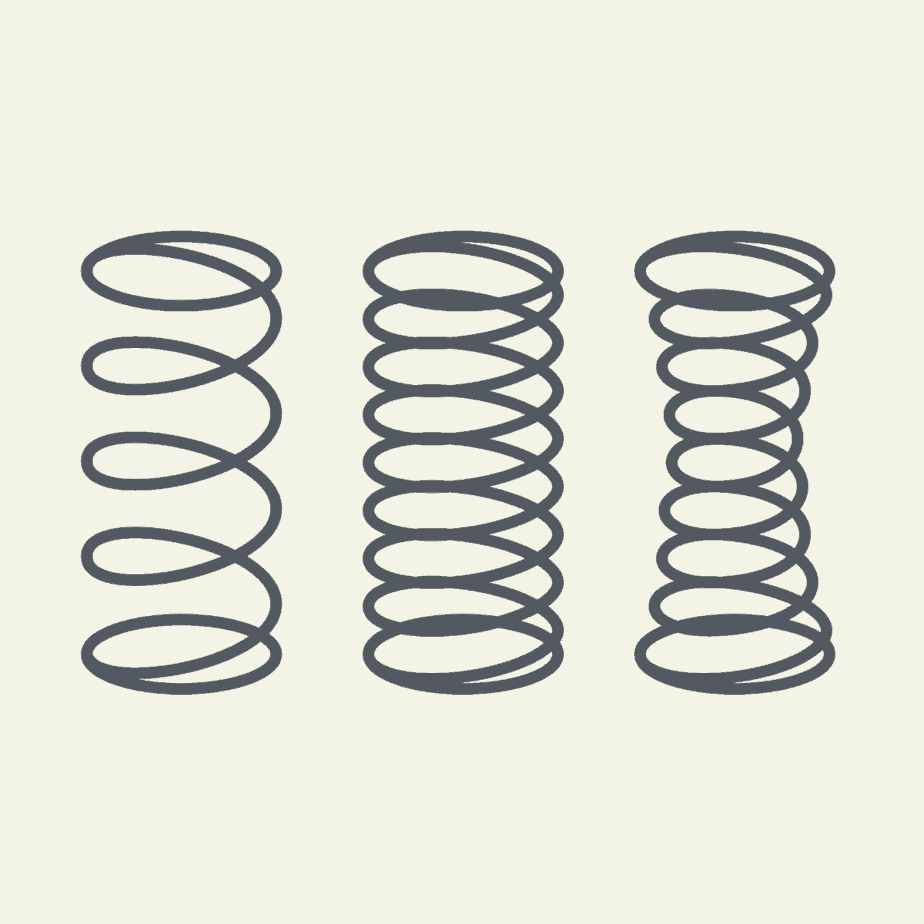When shopping for a new mattress, one of the inevitable questions that’ll pop up on your mind is how long you can realistically expect it to last. Knowing this can help you decide how much to spend and the level of quality to target.
How long can a mattress last while providing good comfort and support? Well, it depends. Even the most well-made models can suffer significant wear and tear if proper care is not given to them. This can reduce their lifespan by as much as half or even more.
Remember, worn-out mattresses can be extremely difficult to sleep on. They may cause all sorts of pain and discomfort such as backaches, headaches, joint pain, and stiffness in several body areas each morning.
Studies have shown that new mattresses may have a positive impact on your overall sleep quality. They can decrease back pain and improve signs of insomnia compared to models 5 years or older.
Thus, if you’re experiencing any of the signs above, getting a new mattress should be top of your to-do list. Well, unless you’d rather aggravate the pain and suffer even more discomfort soon.
What is the Average Lifespan of a Mattress?
Studies have shown that the majority of consumers change their mattresses every 7-10 years. Whether they only do so after the mattresses become uncomfortable to the point where they can barely sleep is unknown.
But if your mattress has reached that mark then chances are you need a new one. In some cases, a mattress can last for over 10 years. This usually occurs in situations where they’re used sparingly. For instance, if you barely receive overnight guests then your guestroom mattress could still look fairly new even after a decade.
Additionally, you should know that all mattresses are not made the same. This means you can only expect up to a decade of use from the premium models that feature superior components and world-class craftsmanship.
If you opt for a mediocre model, you can expect to be shopping for a new mattress after a couple of years at best.
Let us delve into the number of years you can expect each type of mattress to last.
Average Lifespan of Latex Mattress
Foam latex models rule the mattress world when in terms of durability and lifespan duration. High-end Talalay latex models can last up to 15 years. However, this can only be possible when you make an effort to maintain it in peak condition.
One of the smartest but easiest ways to maintain latex is to flip it 180 and 360 degrees regularly. This can protect one spot from developing lumps and sagging due to excessive pressure from your body as a result of overexposure.
Mattress toppers can also enhance the longevity of your foam latex significantly. When your topper wears out, you can always get a quick replacement so your latex mattress can continue to stay in mint condition.
Average Lifespan of Memory Foam Mattress
Memory foam slowly reacts to pressure, unlike foam latex. This makes it a better anti-sagging material overall.
However, overexposure to excessive pressure can still cause those spots to sag over time. The good news is that memory foam can last up to 10 years on average when you take proper care of it.
Like other mattress types, memory foam can last longer when you regularly flip them to sleep on different sides. Besides, you can always add a topper to the mix to serve as a buffer between the mattress and the sleeper’s body.
This can only improve the lifespan of your mattress.
Fortunately, toppers are relatively cheaper than brand new full-blown mattresses meaning they can offer a very economical way of maintaining your mattress.
Coiled Springs Mattress

Spring coils can be prone to sagging. In worse case scenarios, it is not uncommon to see springs protruding out of these mattresses after only a couple of years.
However, the most durable models which usually feature individually encased pocket coils may have an average lifespan of about 8 years. Again, this is not a given and care should be taken to ensure the mattress can last that long.
Experts recommend flipping innerspring mattresses every couple of months to achieve maximum performance and durability.
Waterbed Mattresses
Waterbed mattresses have an average lifespan of about 10 years. But, they come with a couple of maintenance requirements that cannot be ignored if you want maximum value for money.
There’s this misconception that waterbed mattresses are fragile and can only a couple of years maximum. But that couldn’t be further from the truth. The absence of springs means little risk of sagging and lumping across the sleeping surface.
Hybrid Mattresses
Hybrid mattresses have an average lifespan of about 5-6 years. This is thanks to the core support springs and foam top combination.
Hybrids are available at relatively high prices compared with models like pure memory foam or pure coiled spring mattresses. You’d think that a combination of two materials would lead to more longevity but that may not be the case.
Even the best hybrids on the market typically show signs of disintegration after hitting the 5-year mark. You may have to seek an alternative if you have no intention of shopping for a new mattress that can last longer.
Futon Mattress
Futons are the way to go if you prefer lying down directly on the floor. On average, futons last approximately 5 years.
This is due to their low-profile engineering which may lead to significant wear and tear by year 5. Many consumers say their futon mattresses begin to provide significantly less support by this point in their lifespans.
Air Mattress
Even the best air mattresses have an average lifespan of 5 years. At that point, the majority of models begin showing signs like struggling to stay inflated after you pump in the air.
It is also common to see structural deficiencies and signs of disintegrated seams.
What Influences the Lifespan of a Mattress?
No two mattresses even from the same model will last the same amount of time. This is because several factors can determine the lifespan of the mattress once it leaves the factory floor.
Here are the most critical factors that can affect the longevity of a mattress.
Frequency of Use
The more a mattress is used, the higher its rate of disintegration. If you only sleep on a mattress once in a while then it is only logical that it will maintain its physical condition for a longer period.
Barely used mattresses can look and feel like brand new many years after purchase due to the minimal pressure they may suffer. This is why guest bedroom mattresses, for instance, typically last longer than those in regular bedrooms.
Durability
This is another important factor that may determine how long a particular mattress can last. The quality of components and craftsmanship is extremely important.
Even under significant usage and pressure, well-made models can hold up much longer than inferior rivals. Like most things in life, the most durable mattresses usually come at higher price tags but they can be worth it in the long run.
Also, there are times when you can snap up a good mattress at a bargain price. Hence, you don’t always have to settle for the priciest one to get a long-lasting mattress.
Body Weight

The principle of pressure applies here as well. The higher the amount of pressure exerted on a specific mattress, the quicker its rate of deteriorating.
Those of us with heavier weights usually exert more pressure on mattresses compared to lightweight consumers. Even the best-made models begin will feeling the pressure at some point leading to sagging, lumps, and other signs of wear and tear.
No wonder many plus-size folks change their mattresses much quicker than their lightweight counterparts.
Maintenance
There are several ways of maintaining the shape and overall state of your mattress. From regular flipping of the sides to protecting the surface from extremely heavy items, proper care can determine how long a mattress will last.
Remember, mattresses also have to be cleaned regularly to prevent dust mites and other allergens from building up.
Besides, they should be disinfected and dried frequently to eliminate the possibility of stale scents, molds, and mildew. Undertaking these maintenance activities can only improve the lifespan of your mattress.
When do you Need a New Mattress?
Sure, you now know the average lifespan of every major type of mattress available for sale today. Now, the million-dollar question is: do you need to change your current one? Well, that may depend on the answers you provide to the questions below.
Has the quality of your sleep tailed off in the last couple of years? Are you waking up with lots of pain in the back and other areas? Is your mattress showing signs of sagging and lumping? If the answer is yes to any of the 3 questions then you probably need a new mattress.
Despite the average lifespan for your specific mattress, there may be times when you might need a new mattress much sooner than you expected. This could be due to buying a low-quality mattress or the failure to provide proper care for it.
Either way, there’s no point in hesitating when you need to get a new one. However, a new mattress can be a significant investment so it only makes sense that you wouldn’t want to shell out on a new one unless it is necessary.
How can you be sure that your mattress is behind the sleep struggles you’re currently experiencing?
Well, the first step is to pay attention to your partner if you share a bed with someone. If he or she is facing similar struggles trying to sleep then this could be an indicator that you have a bad mattress.
Also, if you notice significant improvements in your sleep every time you spend the night on the sofa or in a hotel room, then getting a new mattress is imperative.
How to Improve the Lifespan of a Mattress
It is no secret that getting a high-end mattress can make a significant dent in your wallet. Therefore, it makes sense that you’d want to protect your investment as much as possible.
After all, even the most durable mattresses require observing stringent practices to keep them in shape for maximum longevity.
1. Use a Mattress Protector
The importance of using a mattress protector or topper right from day one cannot be overemphasized. If you’re shopping for a new mattress, you cannot afford to not purchase a matching protector.
But how do mattress protectors operate and why are they so important? Firstly, these protectors are laid on top of the regular mattress. So instead of making direct contact with the mattress while you sleep, the body feels the protector instead.
This can save the mattress from dirt, dead body cells, stale body oils, and bacteria which may negatively impact the lifespan of the mattress.
Toppers or protectors may also protect the mattress from feeling the maximum effect of the sleeper’s body weight. This means minimal pressure resulting in a lower rate of wear and tear over many years.
Even when the protector wears out, you can always order a replacement to help the mattress continue to stay in shape.
Besides, the majority of protectors are waterproof meaning they can protect the mattress from overnight bladder accidents among children and senior citizens. If you love eating in bed, your protector can be vital by shielding the mattress from food and beverage stains.
Additionally, protectors can cushion mattresses from sagging, lumping, and other common indentations.
2. Flip The Sides of Your Mattress Regularly
Industry experts continue to tout the benefits of flipping your mattress regularly. We get that you probably have a preferred side for sleeping. However, lying down on that same spot night after night can only lead to sagging of that spot.
This can make the mattress appear uneven which can further diminish your sleeping comforts. Besides, sagging mattresses can also cause lots of back and joint pain.
Ideally, sleeping on a different spot every night would be perfect. But, many people find the rotation of their sleeping spots easier said than done. The good news is that flipping your mattress regularly can get the job done with minimal stress.
For the best results, flip the mattress, not just 360 degrees but 180 degrees as well. Make sure to flip it every month during the first 1-2 years. After that, flipping every 3 months or so should be just fine.
Regular flipping is more critical in memory foam, latex, innerspring, and hybrid mattresses. Other types may be just fine without flipping at all or doing it once or twice a year.
3. Keep Your Pets Away

Sleeping with your pets is one of the quickest ways to mess up your mattress. You may be able to get around a lot of the issues with a mattress topper. But why not just get your pets their bed so they do not have to sleep in yours?
This can protect your mattress from dirt and allergens common in puppies and cats. Your mattress can also stay protected from pet dander and potentially harmful organisms pets may inevitably introduce into your bed.
Can a Mattress Last for 20 Years?
The answer is yes. High-end latex mattresses can last for 20 years if they’re sparingly used and receive the highest standards of care.
Note that you may have to shore them up with toppers right from the very first day and observe the most stringent practices.
Conclusion
The average lifespan of a mattress is about 8-10 years. But you can only achieve that level of longevity by observing the recommended maintenance practices such as flipping the mattress regularly, keeping pets away, and cushioning with mattress toppers.
Ordering a quality model is critical to getting the best bang for your buck with regards to not only performance but longevity as well.
